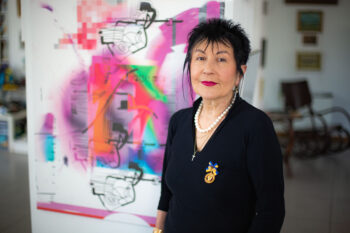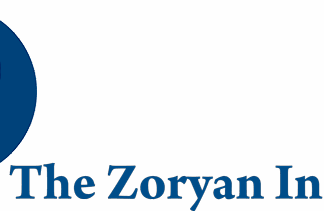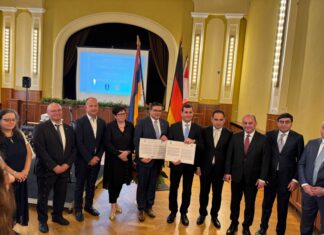BERLIN — Art is a language, like poetry, but is visual. It speaks through metaphors and allegories, communicating across verbal language barriers, through images, figurative or abstract. An exhibition has opened in Berlin in which the artistic language of communication is mythology. Entitled, “Mythical Images – On the Relevance of a Refuge,” it opened on March 28 and will run until April 20, at InteriorDAsein, an atelier and meeting place for artists founded by Archi Galentz. Galentz, a third-generation Armenian artist, has been living and working in the German capital since 1992.
The current exhibition is a sequel to an earlier show, “Through Mythical Zones,” presented in the producer gallery SpiritTransfer in Moers near Duisburg, which featured works by Galentz and Edwin Dickman, who died in December 2023 at the age of 94. The new exhibition expands on it, adding works by Tigran Tokmajyan (1923-2004), Peter Hahlbrock (1934-2015), Gisela Breitling (1939-2018), Gisa Hausmann (1942-2015), Aude de Kerros, Thomas J. Richter, Oleg Neishtadt, Philipp Mager, Julia Katan and others. The works displayed were created between 1958 and 2025: sketches, woodprints, etchings, lithographs, watercolors, oil paintings, and AI-generated prints.

The Language of Myth
As mentioned in a review of the exhibition that appeared on April 4 in Orer from Prague, myths take on a “special dynamic in times of societal upheaval,” like those we are going through today. The viewer must possess “a certain education and preparation to gain access to these visual worlds, whereas the artists must reinterpret and restructure the stuff of mythology content over and again. Neither of these processes unfolds quickly, and there is no single canon” which defines criteria.
The language of mythology can articulate ideas in our modern world, playing a “creative game of associations and drawing parallels between the characters and dramas of ancient times and those of our modern world,” the magazine writes.
Archi Galentz has been fascinated with myths since the beginning of his studies as an artist. According to his teacher, Klaus Fussmann, he found it easier to immerse himself in mythology because, as an Armenian, he belongs to an ancient cultural world, the world of myths that anthropologist and ethnologist Claude Levi-Strauss referred to as the “savage mind.” Galentz found in Edwin Dickman a likeminded artist, perhaps because the latter, an American, was of Irish origin, partaking of a culture rich in mythology. Galentz writes that his own work with myths is not a matter of archival research, but rather a “performative act” that lives through its interpretation. One can transpose myths, like allegories, into the modern world, even with the use of modern technical means. Galentz has experimented here even with artificial intelligence, producing AI-generated pictures.








